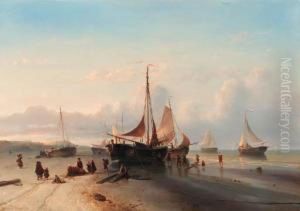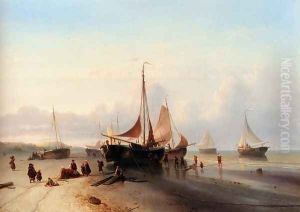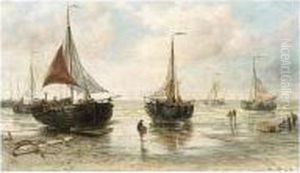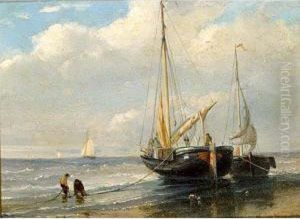Mauritz Verveer Paintings
Mauritz Verveer was a Dutch painter, etcher, and lithographer, known primarily for his contribution to the Hague School. Born on August 30, 1817, in The Hague, Netherlands, Verveer established himself as a significant figure in 19th-century Dutch art, capturing the romanticized essence of the Dutch landscape and Jewish life of his time. His works often depicted scenes of the Dutch countryside, seascapes, and daily life, imbued with a sense of realism and emotional depth that was characteristic of the Hague School artists.
In the early stages of his career, Verveer was influenced by the Romantic movement, which was evident in his dramatic use of light and shadow, as well as in the emotional undercurrents of his paintings. However, as his style evolved, he began to incorporate more realistic and detailed depictions of his subjects, aligning with the aesthetics of the Hague School, which sought to capture the beauty of the Dutch landscape and the nuances of everyday life through a more naturalistic lens.
Verveer received his artistic training at the Academy of Art in The Hague, where he was exposed to the works of the Old Masters, which had a profound influence on his development as an artist. Throughout his career, he was highly regarded by his peers and art critics alike, and his works were exhibited in numerous art shows across Europe, earning him a considerable reputation.
Beyond his paintings, Verveer's contributions to the art world included his efforts as a teacher and mentor to young artists, as well as his involvement in the art community in The Hague. He was a member of several prestigious art societies, including the Royal Academy of Art in Amsterdam, where he was recognized for his artistic achievements and contributions to Dutch art.
Mauritz Verveer passed away on January 5, 1903, in The Hague. His legacy lives on through his influential works, which continue to be celebrated for their portrayal of the Dutch landscape and life, capturing a bygone era with authenticity and artistic grace. Today, his paintings can be found in many important collections and museums around the world, testament to his enduring impact on the world of art.



